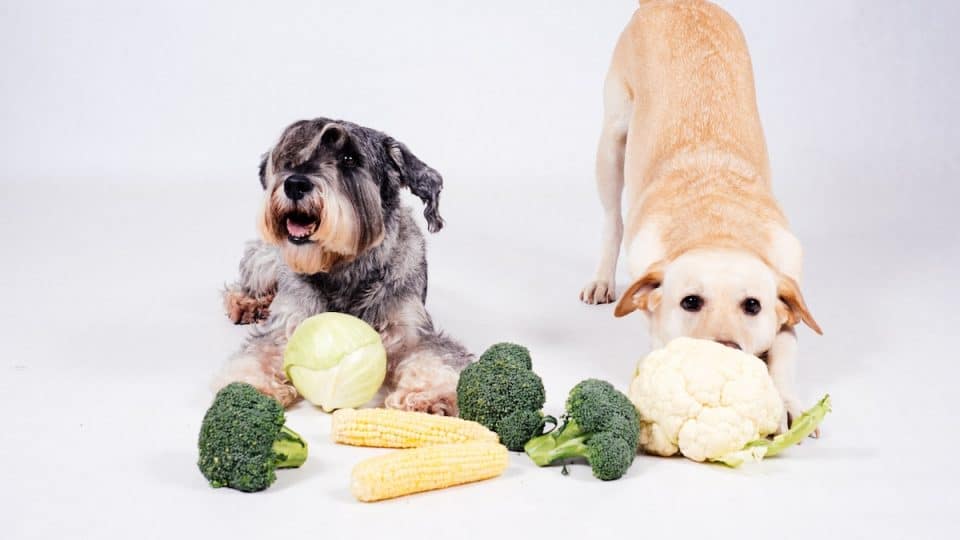- Not a substitute for professional veterinary help.
Like their humans, dogs can eat a variety of veggies as part of a balanced diet—and that includes nutrient-dense cauliflower.
Cauliflower contains several good nutrients, including vitamins C and K, fiber, and antioxidants. It’s also low-calorie and hydrating, since it’s more than 90% water. While dogs can eat it raw or cooked, cooked is softer on the digestive system and on teeth. It should be given in moderation, however—only 10% of a dog’s daily calories should come from foods outside of their main diet (whether that’s kibble, canned, or fresh).
Dr. Iram Gladan, DVM and writer for Breed Atlas, and Dr. Katherine Oakes, Clinical Nutrition Intern at the Veterinary Health Center at Kansas State University, gave us some guidelines on feeding your dog cauliflower.
Types of Cauliflower Dogs Can Eat and How To Prepare It
Both raw and cooked cauliflower can be good for dogs, though your buddy may make their preferences known. Wash and safely handle and store it. Never add seasoning for the portion you’ll feed your dog—that includes oil, butter, or salt, says Oakes. Onions, garlic, and some herbs and spices can be toxic.
Give your dog small serving sizes of cauliflower to eat. Generally, small dogs can have one to two florets per day, while medium dogs can have two to three florets, and larger dogs can have up to four pieces.
Raw
Raw cauliflower can be tougher to digest in large amounts, says Oakes, so keep these portions smaller than you might otherwise.
Cooked
Boiling, steaming, or baking all break down fibers so cauliflower is easier to eat for all dogs, including seniors or those with dental issues. Cooking also helps minimize potential bacteria or pesticides in the vegetable.
Riced
Dogs can have riced cauliflower—processed to resemble grains of rice and used as a rice substitute—as a meal addition, raw or cooked.
Cauliflower stem
While this part of cauliflower is OK for dogs, it is harder and more fibrous than the florets, so it’s more of a choking hazard. Make sure it’s cut into small bite-sized pieces—or even better, cook it to soften.
Leaves
Cauliflower leaves aren’t very plentiful in a standard store-bought head of cauliflower, but they are safe for dogs to eat, so it’s fine if they’re mixed in with your dog’s portion, raw or cooked.
Cauliflower mixed with other vegetables
Cauliflower can be mixed with any other dog-safe vegetable to make for a fun treat and diverse diet. See our list below for nutritious options.
Risks of Dogs Eating Cauliflower
Cauliflower is a safe treat for dogs. However, keep a few important health risks in mind.
- Digestive problems: Since cauliflower is high in fiber, giving your dog too much could overburden their digestive tract and cause gas or diarrhea. Cooked cauliflower is easier for dogs to digest.
- Choking hazard: Large pieces of raw cauliflower can pose a choking risk, especially for small dogs, puppies, or dogs who tend to swallow large chunks of food whole. Always cut this veggie into small, manageable pieces.
- Allergies: While rare, a cauliflower allergy is possible. Pay attention to any signs of a negative reaction when you give it to your dog for the first time, like digestive distress or itchy skin.
- Overfeeding: Dr. Gladan says while cauliflower can be a nutritious snack, it should not replace your dog’s balanced diet. “A good diet for your dog must be varied to meet their nutritional needs,” she says. “If you want to experiment with adding cauliflower to your dog’s daily feeding regimen,” Oakes adds, “refer to your regular veterinarian for a personalized diet recommendation.”
When Can Dogs Not Eat Cauliflower?
Dogs on prescription diets for health conditions should stick with those, says Oakes. Check with your vet before adding anything.
Cauliflower that’s been seasoned for human consumption cannot be shared with dogs, since some seasonings can make them sick or cause unhealthy nutritional imbalances.
As omnivores, however, many dogs can eat a range of fruits and vegetables—provided they’re interested—as a healthy treat.
In addition to cauliflower, dogs can eat:
- Carrots. Many dogs love the taste and crunch; they provide beta carotene, potassium, and vitamins C and B6.
- Green beans. Contain fiber, omega-3 fatty acids, calcium, folic acid, and iron, along with vitamins A, C, and K.
- Beets. These can boost your pup’s immune system and digestion with fiber, vitamin C, folate, manganese, and potassium.
- Sweet potatoes. High in fiber plus vitamins C and B6.
- Raspberries. Contain fiber, vitamins, and antioxidants.
- Spinach. Rich in calcium, iron, and fiber, along with vitamins A, B, C, and K.
- Peas. Contain B vitamins, zinc, and fiber, which can help support your dog’s heart health, vision, muscles, metabolism, and brain.
- Radishes. Packed with fiber, vitamins, and antioxidants, plus important minerals like vitamin B6, vitamin C, calcium, manganese, and potassium.
- Celery. Contains vitamins, minerals, antioxidants, and other good nutrients—watch out for their fibrous strings when raw. Chop them into smaller pieces or lightly cook.
- Broccoli. Broccoli has vitamins C and K, potassium, calcium, and fiber.
Check with your vet before offering your dog a lot of any new food, and pay attention for bad reactions, like stomach distress or itchy skin.



